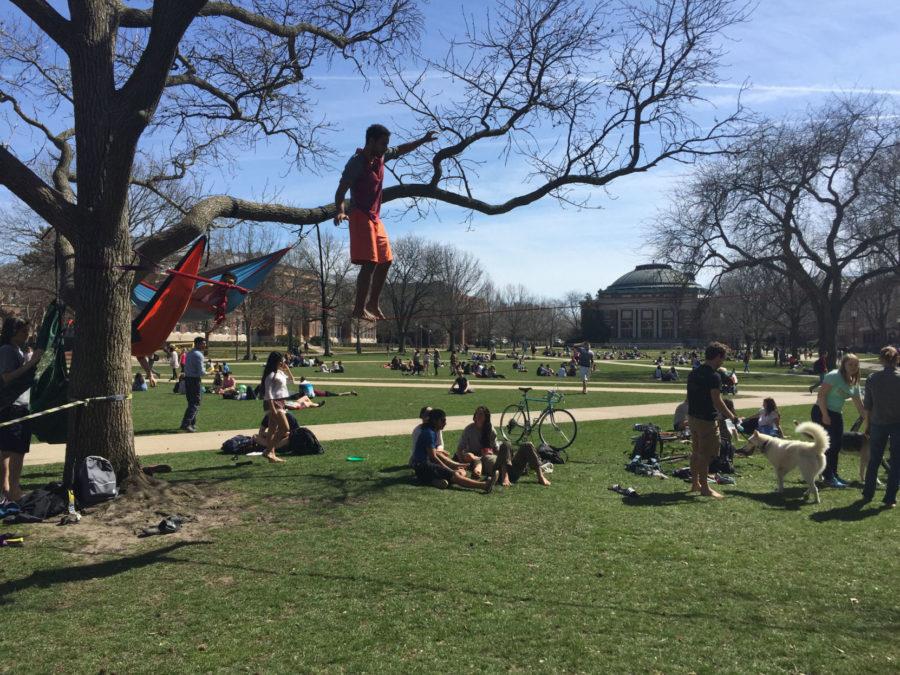Student slackers exercise on Main Quad
April 6, 2015
When the temperature goes up, so do lines of webbing that connect the trees on the Quad.
Students will wobble and hop onto the primary-colored lines and attempt to cross before dropping onto the sweetgum balls scattered in the grass.
Most people know the students as tightrope walkers, but they are actually slackliners or “slackers.”
Mallory Wall, freshman in Engineering, described the webbing as “hard” and “kind of bouncy,” like a trampoline.
“I just want to be able to walk on it,” she said after her initial attempt.
Get The Daily Illini in your inbox!
While the same principle of balancing on an elevated line applies to tightropes and slacklines, the slackline is made of a tubular webbing anchored between two points. This makes it much more elastic than the thin wire typically used for tightrope walking.
Horace Yang, senior in LAS, owns one of the slacklines used on the Quad. He said he has been slacklining for almost two years.
“I just enjoy being in the outdoors,” he said, and added that he is fine with anyone using his slackline, as long as he’s there.
Yang said he has watched the slackline community grow over the years, with more people giving into their curiosity. As people watch others slackline, he said they become less afraid.
“There’s really no getting worse,” Yang said. “Every time you get on it you get a little better.”
Yang is also the informal president of the slacklining club, which was created but never holds meetings, he said.
“People came out anyway. I didn’t really see a point in it,” he said.
Many of the members who slackline are also in the University’s Climbing Club, Yang said.
Cristian Novoa, senior in LAS and member of the Climbing Club, said there was a uniting factor between the slackliners.
“Most of the people here know each other. It’s a good way to be out,” he said. “It’s an excuse to be outside. It’s not so much about doing the slackline itself.”
Novoa said he has been slacklining since last fall, and the technique came naturally to him.
He added that he has always enjoyed learning new ways to manipulate his body.
“I think anybody can do it anyway,” Novoa said. “Your body just learns.”
Samantha Yadron, sophomore in LAS, said she started slacklining last September for the community aspect.
As a transfer student, she said she did not know many people before getting involved, but she joined the Climbing Club and continued to meet people through slacklining.
“Everybody’s just trying their thing, doing what they do,” she said.
Slacklining has relaxing, meditative qualities, Novoa said.
“You’re focused on it and nothing else,” he said. “Your mind is completely into something.”
This has been developed into the practice of slackline yoga, which was created by rock climbers Sam Salwei and Jason Magness in 2005.
“It really works for me,” said Halie Kastl, senior in LAS. “You have that same mental space that you do in meditation.”
Kastl discovered slackline yoga while looking up slackline trick videos and said it was like nothing she had ever seen before.
“It’s like a personal growth,” she said.
There are no instructors in the area, so Kastl said she has been learning through online tutorials.
Slackline yoga focuses on the zen qualities of the line, such as how the webbing moves and reacts to each pose, she said.
“You find a zen spot on the line when you’re walking,” she said. “You don’t really have thoughts at that point.”
The poses, or asanas, are adapted for the slackline, but she said sitting on the line is one of the most difficult poses. The Buddha pose, lying down on the line, is another difficult pose.
She recommended trying either yoga or slacklining and then incorporating the techniques.
“They nurture each other,” she said.







